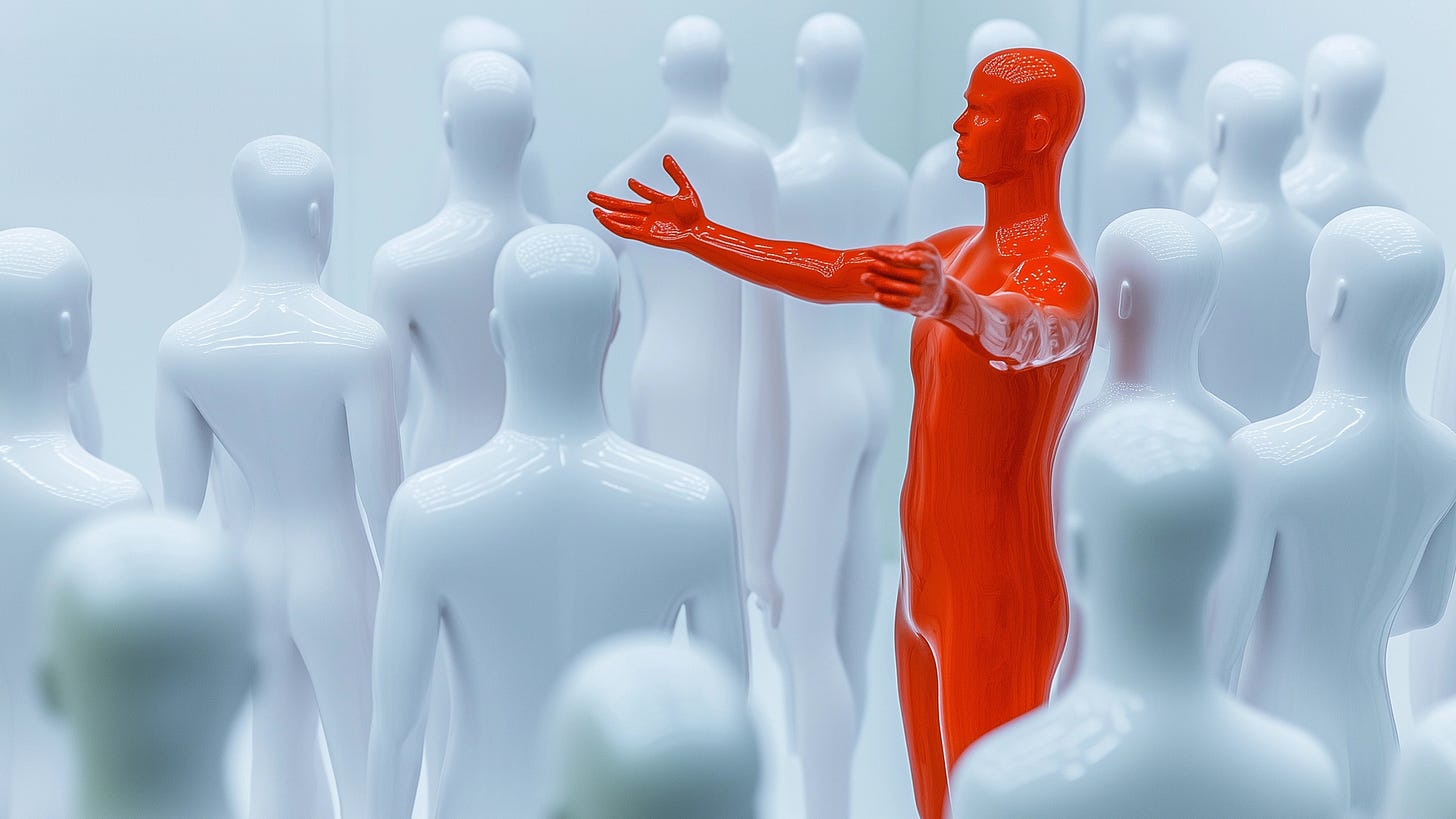Brands are getting boring—and it's only getting worse
The sameness epidemic is real. Here's how the best companies are escaping the digital sludge and building brands you can feel.
Scroll through enough websites, open a few airline apps, or browse the latest crop of Instagram ads—and it all starts to blur. Same templates. Same language. Same “data-driven” performance claims. It’s not just laziness. It’s a structural issue.
As someone who’s been working in commercial advertising and design for top brands for more than two decades, I’ve seen this pattern before. It’s what happens when good work becomes too influential. Remember the glossy icons that came with early Mac OS X? For a few years, every logo, app, and header tried to mimic that high-sheen, faux-dimensional style. It didn’t matter if it made sense for the brand—it was just what you did. And now, we’re living through a more subtle version of the same problem.
Look through the portfolios of new designers—and even the most celebrated ones—and you’ll notice a strange uniformity. The work is undeniably polished. The grids are clean. The type is tight. But it all feels the same. In an industry built on inspiration, we’ve crossed a line into imitation. Whether it’s Behance, Dribbble, or agency reels, we're seeing a creative monoculture: safe, trend-driven design that passes the sniff test, but rarely leaves a mark.
AI is only adding to the noise. Tools like Midjourney and ChatGPT make it easy to build something passable in record time—but they also lower the creative ceiling. With everyone feeding on the same references and outputs, the risk of creative homogenization gets worse.
This brings us to this week’s guest—someone who’s not only aware of the problem but actively working to fix it. Andrew Howlett, CEO of Struck, a Salt Lake City-based advertising agency, and a recent guest on Eggs! The Podcast has made a career out of fighting sameness with experiences people can feel. His approach to branding goes beyond the screen and into the physical world, challenging the notion that a “digital-first” strategy is the only way forward.
Meet the ad executive turning brands into places, walk through, sit in, and remember forever.
For Andrew Howlett, sameness isn’t just a creative risk—it’s a strategic failure. As CEO of Struck, a Salt Lake City-based agency known for bold campaigns and immersive experiences, Andrew is leading a quiet revolution against the cookie-cutter branding infecting the industry. With a background in tech, finance, and software development, he brings a rare blend of strategic rigor and creative ambition to the table.
He’s reimagined Nickelodeon’s headquarters as a story-rich creative space, helped Lagoon overhaul its guest experience from the ground up, and even been tapped by Disney Imagineering to consult on their own internal environments. His bet? That the most valuable brands of tomorrow won’t live in a file—they’ll live in memory.
How to Stand Out in a World of Sameness
“We’re in the experience economy now. What people remember is how they felt—everything else is noise.
The Insight: Prioritize emotional resonance over surface-level polish. Ask yourself: What do customers feel when they interact with your brand—in person, online, or otherwise?
“Open any airline app, and they all look the same. Why? Because they’re all licensing the same platform. There’s no differentiation left.”
The Insight: Technology can make your brand efficient—but also invisible. If you're using common platforms, invest in custom design or experiential elements to break the mold.
“You don’t buy something because of great source code. You buy it because you felt something.”
The Insight: Stop obsessing over features and functionality alone. Tell a story. Design for the moment when emotion tips a customer into action.
“A strong brand reduces your need to advertise. A weak one makes you overspend just to be noticed.”
The Insight: A well-developed brand acts as a multiplier across all your efforts. Invest early in building a differentiated identity—it will save you time and money down the road.
“Our job is to create experiences that drive emotion—because emotion drives action. Always has.”
The Insight: Every campaign, space, or touchpoint should be reverse-engineered from the emotional response you want to create. Start with how they should feel, not what you want to say.
“AI is a powerful tool—but if everyone has it, nobody has an edge. The advantage is still human.”
The Insight: Don’t outsource your soul. Use AI to speed up execution, not replace the thinking, originality, and intuition that set you apart.
“The most iconic brands didn’t grow because of their ads. They grew because people wanted to be part of them.”
The Insight: Cultivate a sense of belonging. Make your brand something people identify with, not just buy from.
Sameness Is Easy. Resonance Is Rare.
In a world flooded with good design and clever messaging, it’s not enough to look the part. Brands that rely on templated aesthetics or trend-chasing strategies will increasingly blend into the noise. But those who invest in creating meaningful, emotional experiences—the kind you remember, the kind you feel—will rise above the rest.
Whether it's through immersive environments, unexpected moments, or simply telling a more human story, the real differentiator isn't more content. It's more connection.
Thanks for reading,
—Ryan
Ready for more?
Catch Andrew Howlett’s interview in its entirety on Eggs! The Podcast.
Don’t miss a show! Subscribe on Spotify, Apple Podcasts, or really anywhere great podcasts are found.
Path Picks
Cool stuff to help you forge your path to greatness.
Note: The Path Weekly is reader-supported. As such, I may be using affiliate links below. If you want to support the newsletter at no additional cost to you, please consider using the links below. If you’d rather not, most items below are widely available anywhere you want to shop. Thanks! –R
Reading list
If you're looking to dive deeper into the ideas discussed in this piece, here are some recommended books and resources that align with Kyle McDowell's principles:
Extreme Ownership: How U.S. Navy SEALs Lead and Win – by Jocko Willink & Leif Babin: A no-BS leadership manual built on battlefield-tested principles, this book argues that the best leaders take complete responsibility—for success, failure, and everything in between. Referenced by Andrew Howlett as a game-changer for agency and brand leadership.
Start with Why: How Great Leaders Inspire Everyone to Take Action - by Simon Sinek: A foundational book for building brands with soul. Sinek’s core idea—that people don’t buy what you do, they buy why you do it—aligns closely with Howlett’s philosophy on emotional resonance and experience-led branding.
The Experience Economy: Competing for Customer Time, Attention, and Money - by B. Joseph Pine II & James H. Gilmore: A landmark book that introduced the idea of selling experiences rather than goods or services. Essential reading for anyone serious about moving beyond pixels to build brands that live in memory.
More to explore
Andrew Howlett
CEO, Struck
Experiential Branding & Design Agency – Salt Lake City, UT
LinkedIn
struck.com
strktr.com (Structure – Struck’s experiential discipline)
Work with me
Ryan Roghaar - Fractional CMO/Creative Director/Art Director: https://rogha.ar/portfolio
R2 - Creative Services for Agencies and SMBs: https://www.r2mg.com
Eggs! The Podcast: https://www.eggscast.com
Would you like a personal introduction to any of the incredible leaders featured in The Path Weekly to explore business or other collaborative opportunities?
Contact me here to learn more about my B2B matchmaking service.
Get featured
Do you want to be featured in a future edition of The Path Weekly?
Contact me to learn more.




